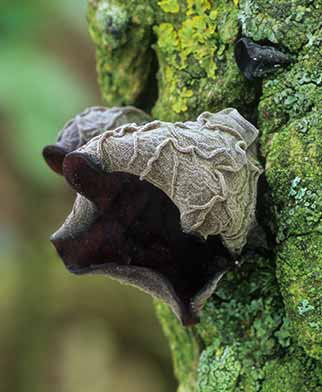Jew's Ear (Auricularia auricula-judae)

Jew's Ear fungus
It is not difficult to appreciate the derivation of the 'ear' element of the Jew's Ear's name, but why Jews should be specially mentioned is a bit of a puzzle. (Continuing in similar theme, an alternative common name is Judas's Ear, and so is Jelly Ear).
Usually found singly or in small groups growing on elder trees, each Jew's Ear fruiting body can extend to around 8 centimetres across, is initially irregularly cup-shaped but eventually develops the more familiar ear-shape.
Although of variable colour, young specimens are typically reddish-brown and of soft, velvety texture on the outer surface, and grey-brown on the inner surface. With age, however, and when particularly dry, the fungus hardens, the outer surface colour fades and takes on a horny, whitish-grey appearance, whilst the inner surface darkens.
Quite prominent veins are often conspicuously visible.
This fungus can be found all-the-year-round, but as elder, its favoured host, is not particularly common in the New Forest, so the fungus is infrequently encountered - it has been found locally, though, growing on willow, oak, sycamore, beech and gorse.
When young and only when cooked, the Jew's Ear is edible, although not particularly popular - its value is said to be more in its texture rather than in its rather bland flavour.
Warning: refer to a good, comprehensive fungus field guide to confirm identification, and only eat those species known without any doubt whatsoever to be edible - people have died after eating certain poisonous specimens.
References:
Mushrooms and other Fungi of Great Britain and Europe - Roger Phillips
The Mushrooms and Toadstools of Britain and North-western Europe - Marcel Bon
Fungi of Britain and Europe - Stefan Buczacki and John Wilkinson
The MacDonald Encyclopedia of Mushrooms and Toadstools - Giovanni Pacioni
Fungi of the New Forest: A Mycota - Edited by Gordon Dickson and Ann Leonard
A Passion for Mushrooms - Antonio Carluccio
More links
Other related links
Search this site

Sadly, 58 animals were killed - 35 ponies, 13 cows, 8 donkeys and 2 sheep, whilst a further 32 were injured - 3 pigs, 9 donkeys, 11 cows and 9 ponies.
(Forty-three accidents occurred in daylight, 15 at twilight and 101 in the dark. Twenty-seven accidents were not reported by the driver involved).
Here's just one horrific example - Three donkeys killed in collision with van at notorious New Forest blackspot (Advertiser and Times)

